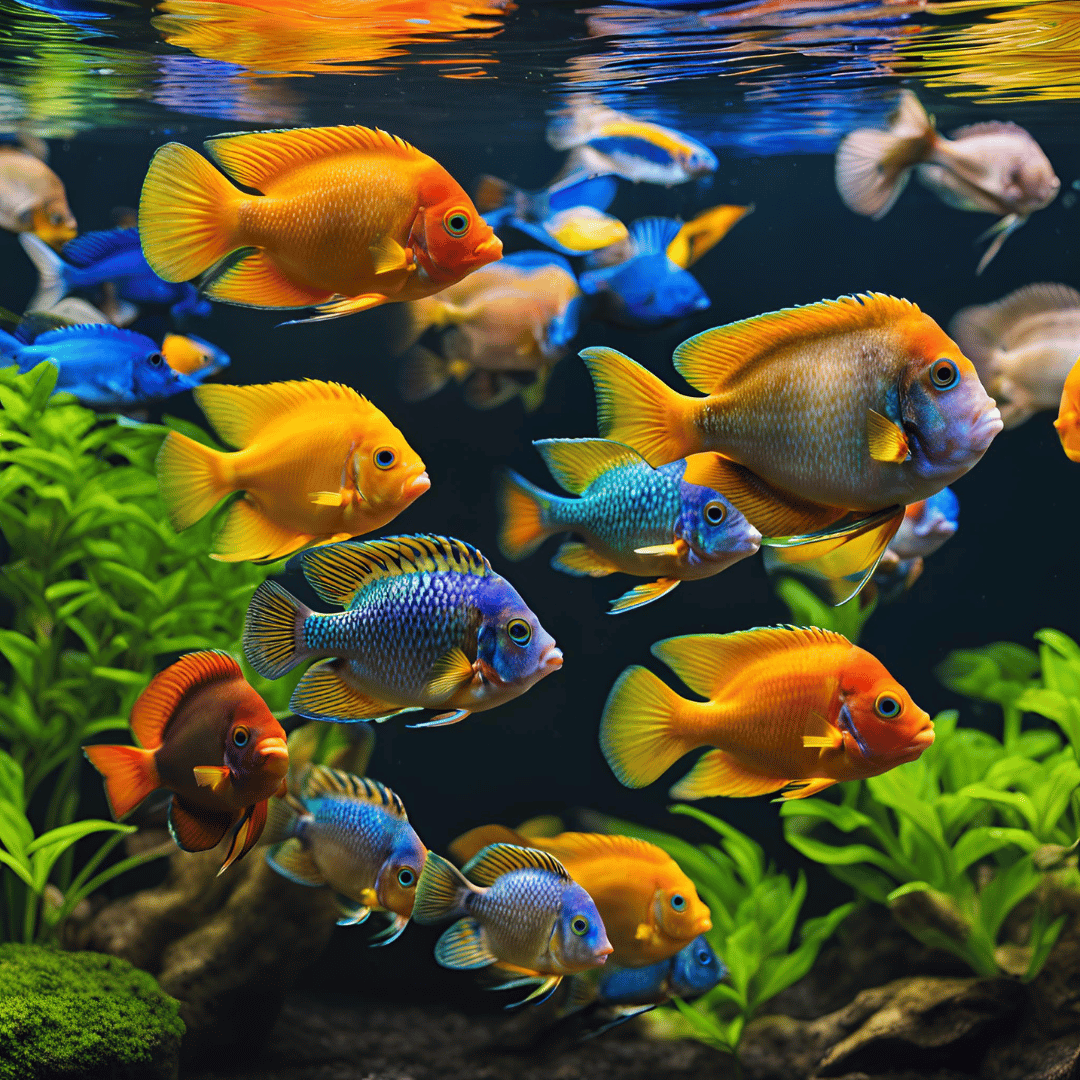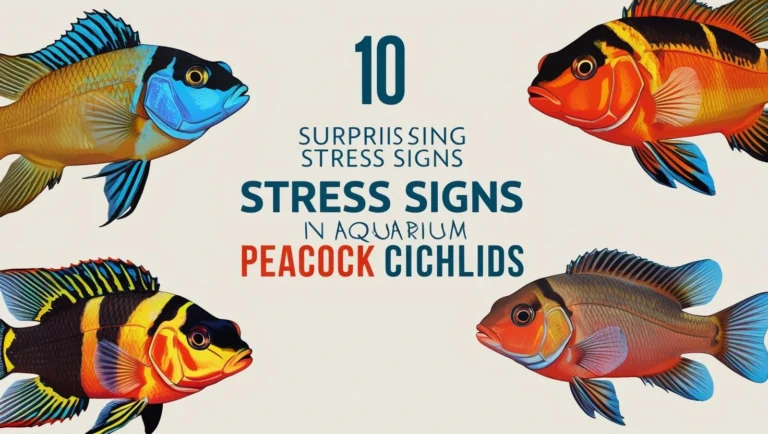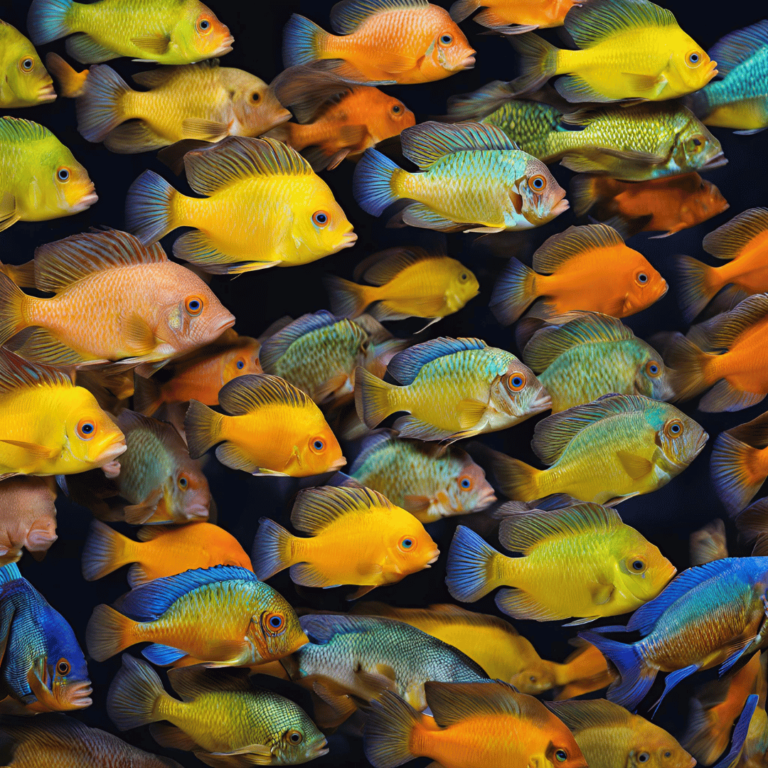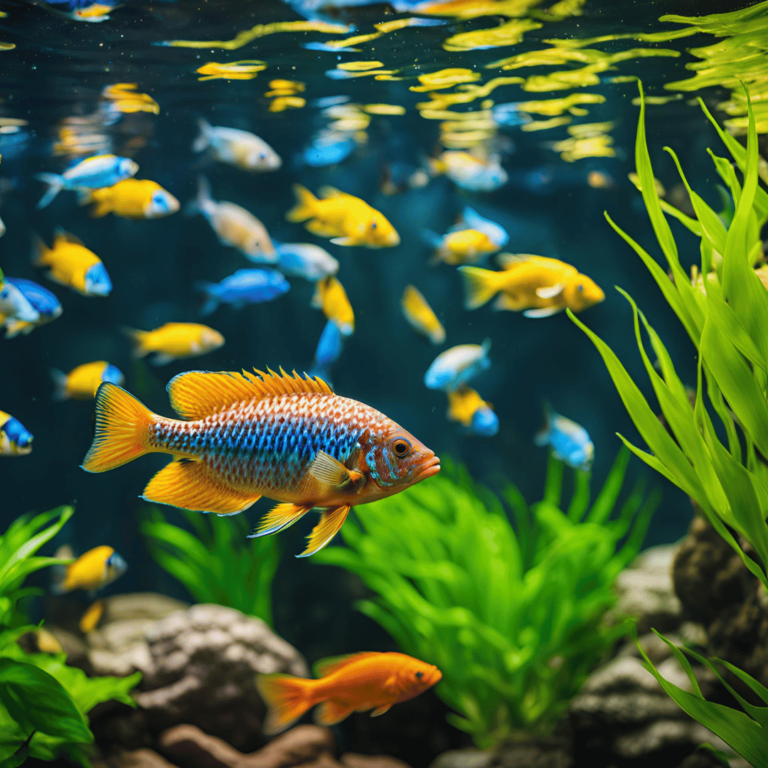Your trusted guide to cichlid care, tank setups, and quality products.

10 Signs of Peacock Cichlid Stress and How to Prevent It
Spot the signs of stress in your peacock cichlids and take action! Our guide explores common behavioural indicators, underlying causes, and effective solutions to create a peaceful and harmonious environment for your fish.
Image credit: Canva
Owning Peacock Cichlids can be incredibly rewarding due to their vibrant colors and engaging personalities. However, recognizing and addressing Peacock Cichlid stress is essential to maintaining their health and well-being. Stress in these fish can lead to behavioral changes and health issues if not addressed promptly.
In this guide, we’ll explore the signs of Peacock Cichlid stress, common causes, and practical solutions to ensure a thriving tank environment.
At PeacockCichlid.com, we believe in transparency and honesty with our readers. Some of the links in this article are affiliate links, which means we may earn a small commission if you make a purchase through them—at no additional cost to you. These commissions help support our site, allowing us to continue providing expert advice, in-depth guides, and valuable content for Peacock Cichlid enthusiasts like you.
We only recommend products that we trust and believe will be beneficial for your aquarium. Thank you for your support!
Signs of Stress in Peacock Cichlids
1. Loss of Color
One of the most visible signs of Peacock Cichlid stress is a noticeable loss of their vibrant hues. When stressed, their pigmentation dulls, signaling that something in their environment is amiss. This loss of color can also indicate underlying health issues, so it’s important to act quickly if you notice this change.
2. Erratic Swimming
Peacock Cichlids are confident swimmers. However, darting, frantic movements, or disoriented swimming patterns can indicate Peacock Cichlid stress. While occasional bursts of energy are normal, consistent erratic behavior suggests discomfort. Erratic swimming might also result from sudden changes in water parameters or incompatible tank mates.
3. Hiding Excessively
Though territorial, Peacock Cichlids are social creatures. If they’re constantly hiding behind decorations or in tank corners, it could indicate Peacock Cichlid stress due to threats, poor water conditions, or aggressive tank mates. Providing adequate hiding spots can help them feel more secure and reduce stress levels.
4. Loss of Appetite
Refusal to eat or a diminished appetite is a critical indicator of Peacock Cichlid stress. Prolonged food avoidance can weaken their immune system, making them more susceptible to illnesses. Stress-related appetite loss can stem from poor diet, aggressive tank mates, or environmental disturbances.
5. Gasping for Air at the Surface
When your Peacock Cichlids are gasping for air at the water’s surface, it often points to low oxygen levels or poor water quality. This behavior is both a sign of Peacock Cichlid stress and an urgent issue needing immediate attention. Aerating your tank and ensuring proper filtration can mitigate this issue.
6. Increased Aggression
While Peacock Cichlids are naturally territorial, sudden and excessive aggression towards tank mates often signals Peacock Cichlid stress. Overcrowding, poor tank conditions, or incompatible fish may be the culprits. Aggression may also escalate during breeding periods, making it important to monitor tank dynamics.
7. Lethargy
Another sign of Peacock Cichlid stress is lethargy. Stressed fish may appear less active, spending more time at the bottom of the tank or avoiding interaction. Lethargy often accompanies other stress indicators and should not be ignored.
8. Clamped Fins
When Peacock Cichlids keep their fins tightly against their bodies, it’s a sign of Peacock Cichlid stress. This behavior is often caused by poor water quality, disease, or aggressive interactions with other fish.
9. Scratching Against Surfaces
If you observe your Peacock Cichlids rubbing against decorations or tank surfaces, it could indicate Peacock Cichlid stress due to parasites or water irritants. Regular water testing and treating for potential parasites can address this issue.
10. Unusual Breathing Patterns
Rapid gill movement or labored breathing can be a sign of Peacock Cichlid stress. This is often linked to water quality issues, such as high ammonia or nitrite levels, and requires immediate attention to prevent further harm.
Common Causes of Stress in Peacock Cichlids
1. Poor Water Quality
Changes in pH, ammonia, nitrate, or nitrite levels can quickly cause Peacock Cichlid stress. Regular testing and maintenance are vital to keep water parameters within the optimal range. Aim for a stable pH between 7.5 and 8.5 and maintain a temperature of 76-82°F.
2. Overcrowding
Overcrowding increases territorial disputes and stress. Ensure your tank is adequately sized for the number of fish, with at least 55 gallons for a small group. For larger groups, consider a tank of 75 gallons or more to reduce tension and Peacock Cichlid stress.
3. Sudden Environmental Changes
Peacock Cichlids thrive in stable environments. Sudden changes, such as water replacement, lighting adjustments, or tank rearrangement, can cause significant Peacock Cichlid stress. Gradual adjustments to the tank environment can help minimize stress levels.
4. Incompatible Tank Mates
Adding aggressive or overly timid fish to the tank can disrupt harmony and cause Peacock Cichlid stress. Choose compatible species to maintain a peaceful environment for your Peacock Cichlids. Good tank mates include other mild-mannered African cichlids of similar size.
5. Lack of Hiding Spots
Without sufficient hiding places, Peacock Cichlids feel exposed and stressed. Incorporate caves, rocks, and plants to create secure areas. These elements reduce Peacock Cichlid stress while enhancing the tank’s visual appeal.
6. Inadequate Diet
An unbalanced diet can contribute to Peacock Cichlid stress. Peacock Cichlids require a mix of high-quality pellets, occasional live or frozen foods, and vegetable matter to meet their nutritional needs. Overfeeding or feeding poor-quality food can lead to health issues and stress.
How to Address Stress in Peacock Cichlids
1. Maintain Optimal Water Quality
Regularly test and monitor ammonia, nitrate, nitrite, pH, and temperature levels to prevent Peacock Cichlid stress. Perform frequent water changes and invest in a reliable filtration system. Adding an air stone can also improve oxygenation.
2. Provide Adequate Space
Overcrowding is a major stressor. Ensure your tank is spacious enough for territories and swimming. Avoid overstocking and consider upgrading your tank size if needed to minimize Peacock Cichlid stress.
3. Add Hiding Places
Enhance your tank’s layout with decorations that offer hiding spots. Rocks, caves, and dense plants help your cichlids feel secure and reduce territorial disputes. Adequate hiding spots are essential to addressing Peacock Cichlid stress.
4. Select Compatible Tank Mates
Choose species that match the temperament of Peacock Cichlids. Avoid overly aggressive fish and species that are too timid, as they can exacerbate Peacock Cichlid stress. Research compatibility thoroughly before introducing new fish.
5. Address Aggression
If aggression becomes an issue, consider rearranging the tank’s layout or temporarily isolating the aggressive fish. This can help reset territorial boundaries and reduce Peacock Cichlid stress. Adding more visual barriers can also disrupt line-of-sight aggression.
6. Offer a Balanced Diet
Provide high-quality cichlid pellets, live or frozen foods, and occasional vegetable matter to support their health. A balanced diet boosts immunity and helps reduce Peacock Cichlid stress. Rotate food types to keep their diet varied and interesting.
7. Quarantine New Fish
Introducing new fish without proper quarantine can introduce diseases and parasites, causing stress in the entire tank. Always quarantine new arrivals for 2-4 weeks to prevent Peacock Cichlid stress.
8. Monitor Tank Conditions Regularly
Routine checks on water parameters, equipment functionality, and fish behavior can help you spot potential issues early. Monitoring tank conditions is critical to minimizing Peacock Cichlid stress.
9. Use Stress-Reducing Products
Products like water conditioners that remove chlorine and chloramine, or those containing stress-relieving additives, can improve water quality and reduce Peacock Cichlid stress.
10. Create a Consistent Routine
Peacock Cichlids thrive on consistency. Maintain regular feeding schedules, water changes, and lighting cycles to reduce stress caused by unpredictability.
Conclusion
By understanding and addressing Peacock Cichlid stress, you can create a thriving, harmonious environment for your fish. From maintaining optimal water quality to providing ample space and hiding spots, these steps will ensure your cichlids remain healthy, vibrant, and stress-free. Monitoring their behavior closely and making adjustments as needed will go a long way in promoting their well-being.
If you found this guide helpful, share it with fellow aquarists and help spread awareness about creating ideal conditions to reduce Peacock Cichlid stress.
Elevate your aquarium care by exploring more expert insights on peacochcichlid.com. For instance, if you’re looking to further protect your fish from health issues that can lead to stress, our guide Top 7 Common Peacock Cichlid Diseases and Prevention Tips is a must-read. New to aquarium keeping? Peacock Cichlid Care: 7 Powerful Tips for Beginners offers a comprehensive roadmap to get you started, while Peacock Cichlid Tank: 10 Expert Tips for a Stunning Setup provides valuable advice on creating a balanced habitat that minimizes stress.
We’re dedicated to helping you build a thriving, peaceful tank, so be sure to check back for more expert advice and follow us on social media to stay updated with the latest tips and trends from peacochcichlid.com.
FAQ’s
What are the main signs of stress in Peacock Cichlids?
The main signs of Peacock Cichlid stress include loss of color, erratic swimming, excessive hiding, loss of appetite, gasping for air at the surface, increased aggression, lethargy, clamped fins, scratching against surfaces, and unusual breathing patterns.
Why do Peacock Cichlids lose their color when stressed?
Peacock Cichlids lose their vibrant hues as a response to stress or underlying health issues. This dulling of pigmentation is a signal that something in their environment is not ideal and requires attention.
How can erratic swimming behavior indicate stress?
Erratic or frantic swimming can indicate Peacock Cichlid stress due to sudden changes in water parameters or the presence of incompatible tank mates. While occasional bursts are normal, consistent erratic behavior is a concern.
What should I do if my Peacock Cichlids are hiding excessively?
Excessive hiding can be due to threats, poor water conditions, or aggressive tank mates. Ensure there are enough hiding spots in the tank and check the water quality to help reduce Peacock Cichlid stress.
What does it mean if my Peacock Cichlid is gasping for air at the surface?
Gasping for air at the surface often indicates low oxygen levels or poor water quality. This is an urgent issue that should be addressed by improving tank aeration and ensuring proper filtration.
Can aggressive behavior be a sign of stress in Peacock Cichlids?
Yes, sudden and excessive aggression can be a sign of Peacock Cichlid stress, often due to overcrowding, poor tank conditions, or incompatible tank mates. Addressing these factors can help reduce stress levels.
What water conditions do Peacock Cichlids need to avoid stress?
Peacock Cichlids thrive in a pH range of 7.5 to 8.5 and a temperature range of 76-82°F. Regularly monitor water parameters, including ammonia, nitrate, and nitrite levels, to prevent stress.
How can I prevent overcrowding and its stress effects on Peacock Cichlids?
Ensure your tank is large enough for the number of fish, with at least 55 gallons for a small group. For larger groups, consider tanks of 75 gallons or more to allow enough space and reduce territorial disputes.
What type of diet helps reduce stress in Peacock Cichlids?
A balanced diet that includes high-quality pellets, occasional live or frozen foods, and vegetable matter helps maintain their health and reduce Peacock Cichlid stress. Avoid overfeeding and ensure food variety.
How can I create a consistent routine to minimize stress for my Peacock Cichlids?
Maintain regular feeding times, water changes, and stable lighting cycles. Consistency helps reduce stress and promotes a stable, healthy environment for Peacock Cichlids.



